According to the CDC [1], every day 586 people are hospitalized for Traumatic Brain Injury (TBI), and this does not include urgent care or emergency room visits for TBI.
This injury can happen from blunt force to the head or your brain getting jostled around. Car accidents, sports, and falls are common culprits of brain jostling.[2] Unfortunately, the brain may be unable to just “walk it off.” Two scientists, Giza and Hovda, investigated the neurometabolic cascade of concussion (2014).

Short-Term and Immediate Effects of TBI
When we get blasted in the head with force, many processes go wrong. Our cells in the brain called neurons have sodium, potassium, and calcium inside and around them. When force hits our brain, these molecules start spilling out of our neurons, while calcium enters in at high rates. Neurons don’t like things moving out of control, so they use a lot of energy to try and get all our important molecules back where they need to be.

However, at the same time, the structural integrity of our neurons is harmed by the blunt force, so the neuron needs more energy to fix this as well! The neuron is now in an energy crisis. Consider when you’ve been pulled in fifty different directions and all you want to do is nap, that is how the neurons are feeling.
Neurons cannot communicate with each other as effectively, and inflammation occurs after TBI. All of these dysfunctions present themselves as brain fog, headaches or migraines, slow reaction speeds, impaired learning, and overall discomfort.
Long-Term Effects of TBI
After severe TBI or patients with multiple TBI injuries, proteins that are seen in neurodegeneration are present. Specifically, tau protein accumulates, which creates tangles in our neurons that disrupt important cell functions and can lead to cell death. Even when cell death doesn’t happen, the tangles can harm cognitive functioning. Cell death can lead to neurodegenerative diseases, but more research is needed to determine the risk of neurodegeneration from TBI.
Neurons are more vulnerable because of the structural damage done after the head trauma. Many neurons have white matter, a protective sheath, but TBI can damage this beyond repair for some neurons. Similar white matter damage is seen in some patients with PTSD and depression.
Protective Measures
The energy crisis and structural neuronal instability can typically recover within 10 days after injury, but repeated injuries too close together may create long-term damage. This raises the important topic of rest after TBI.
Rest after TBI can help the neurons get back to normal functioning levels. More research is needed to understand the exact length of time needed to recover, but it’s highly important to prevent a further head injury.
The more scientists understand the mechanisms behind concussions and TBI, the closer they can get to preventing long-term damage. Until then, watch your head!
Resources
[1] Centers for Disease Control and Prevention. (2024). TBI data. Centers for Disease Control and Prevention. https://www.cdc.gov/traumatic-brain-injury/data-research/index.html
[2] Mayo Foundation for Medical Education and Research. (2021, February). Traumatic brain injury. Mayo Clinic. https://www.mayoclinic.org/diseases-conditions/traumatic-brain-injury/symptoms-causes/syc-20378557
[3] Giza, C. C., & Hovda, D. A. (2014). The new neurometabolic cascade of concussion. Neurosurgery, 75(Supplement 4). https://doi.org/10.1227/neu.0000000000000505